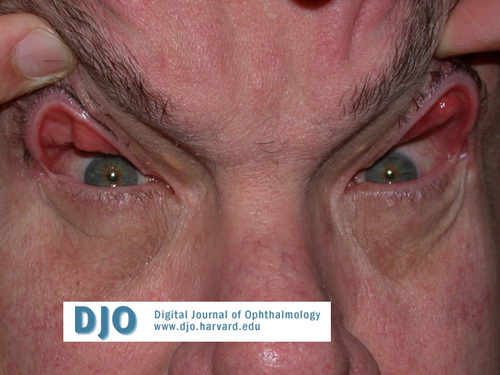|
|
 |
 |
 |
 |
|
|
Orbit/Oculoplastics Quiz 10
|
Printer Friendly
|


 Corey Westerfeld, M.D.
Corey Westerfeld, M.D. | Massachusetts Eye & Ear Infirmary Aaron Fay, M.D. | Massachusetts Eye and Ear Infirmary April 14, 2005
|
|
[Back to Questions] [Back to Orbit/Oculoplastics]
|

Figure 1
Appearance at presentation.
|

Figure 2.
The patient's eyelids everted easilly.
|
| | Case History | | A 68 year old male presents complaining of droopy upper eyelids and eye irritation and burning for several months. | | | Questions and Answers | 1. What is the diagnosis?
Answer: The patient has floppy eyelid syndrome.
2. What characteristics define this condition?
Answer: Floppy eyelid syndrome is characterized by flaccid upper eyelids that spontaneously evert. Patients with floppy eyelid syndrome often present with unilateral or bilateral chronic eye irritation and burning. The characteristic clinical finding is chronic papillary conjunctivitis. Other clinical findings include ptosis, lash ptosis, and eyelid imbrication.
3. What pertinent history should be elicited?
Answer: Patients often have a history of sleeping prone, or on the affected side, which can cause mechanical upper eyelid eversion and resultant conjunctival irritation from contact with a pillow or bed sheets.
4. What are the histopathologic features of this condition?
Answer: The histopathologic feature most specific to floppy eyelid syndrome is a decrease in elastin fibers in the tarsus. This has been demonstrated using Verhoeff’s modified elastin stain and explains the loss of rigidity in the lids of patients with this syndrome.
5. What other conditions are associated with this disease?
Answer: Floppy eyelid syndrome almost always occurs in obese patients. Other associations may include eyelid rubbing or mechanical pressure, keratoconus, hyperglycemia, and sleep apnea. Obstructive sleep apnea is a potentially fatal condition that should be evaluated in patients with floppy eyelid syndrome. It is important to inform the primary physician of this correlation. Sleep studies are recommended.
6. What are the treatment options?
Answer: Conservative therapy consists of eyelid shielding, particularly when sleeping. Lubricating and steroid ointments may also afford some benefit. Often, however, surgical treatment is necessary. Surgical treatment focuses on horizontal shortening of the involved lid and is not directed primarily at correcting the ptosis. Lid tightening alone may allow for inflammation to resolve and, subsequently, ptosis to improve. Patients should be instructed to continue to wear the sheilds to prevent recurrence.
| | | [Back to Questions] |
|
 |
 |
 |

|
|
 Welcome, please sign in
Welcome, please sign in  Welcome, please sign in
Welcome, please sign in